The following article appeared in the July 1935 issue of the Riverdale News as a continuation of the memoir of 19th century resident, J.B. James.
Photos added by Nick Dembowski, who transcribed and annotated the memoir.
J.B. James Continues His History of These Parts
About the close of the Civil War, a horse-car line was constructed on Broadway from Yonkers to Kingsbridge. It was not successful and was abandoned, the tracks taken up when Broadway was straightened and widened. Kingsbridge then was a small place with very few stores and most of the residents, as well as those in Riverdale, did their shopping in Yonkers. The horse-car line tried to promote this. An amusing story was told me by an old resident in connection with this. One of the female residents of Kingsbridge bought a package of matches–the old sulphur kind in small paper boxes–at a store in Yonkers. The next day she took them back, claiming that they would not light. The shopkeeper took one and scratching it on the seat of his pants, held it up blazing before her face. She was pleased for a moment, but equal to the occasion, and remarked–“Humph!” If you think I’m coming all the way from Kingsbridge to scratch a match on the seat of your pants when I want a light, you are very much mistaken!”

Old Landmarks
With the growth of the city northward many old landmarks were obliterated. At Kingsbridge, the curve of the creek was filled in and the bridge torn down [Note: These are the Spuyten Duyvil Creek and the King’s Bridge]. In the creek, in front of the residence of Joseph Godwin, was a small island on which grew a good-sized tree. Reposing in the center was an object of much interest to the youngsters of the neighborhood–a life-size wooden swan [See image below]. A short distance north of the present railroad station was a small graveyard and vault containing the remains of early settlers. This has disappeared [Note: It is unclear to which station he is referring]. The Mosholu, from its junction with the Spuyten Duyvil Creek, up to the foot of the gardens at Van Cortlandt Park has been also filled in and is now partly covered by houses on its southern part [“Mosholu” was the name given to Tibbetts Brook in the 1800s]. The Mosholu Creek was a tidewater stream, winding through the meadows from Kingsbridge to the park, and in olden days floated flatboats that carried farm produce down to the city [From the “Town Dock,” which is discussed here]. On it was an old flood gate forming part of a dike, west of Broadway, and at about 241st Street. When the low ground was filled in this also disappeared. On the west side of the Albany Post Road, about on block north of the terminus of the subway, stood an old landmark known as Warners’ store, a large frame building with two pillars on the front, which was also the post office of this locality. It was built probably about 1848 and was run by the Warner brothers as a general country store. I have bought candy and fishhooks there many times. As a store it was given up within my recollection. The building stood until recent times. The foundations still remain. In front of it was a well, and large hay scales, the box of which was lettered “Mosholu P.O.” In my early days existed on the terrace above the garden in the park, a row of box trees of great age and size, so large, in fact, that we used to climb up in them. The people in the neighborhood believed that the odor from them–which indeed was strong–was the cause of the frosted appearance of the window glass in the old mansion [Van Cortlandt mansion]. I managed to procure a piece of this glass from a broken window pane and submitted it to a scientific acquaintance for analysis. He reported that its peculiar appearance was due to some imperfection acted upon by changing temperature and weather. The large carved wooden vultures, now in the mansion, formerly adorned the gateposts of the driveway under the huge horsechestnuts. I have shied many stones at them.
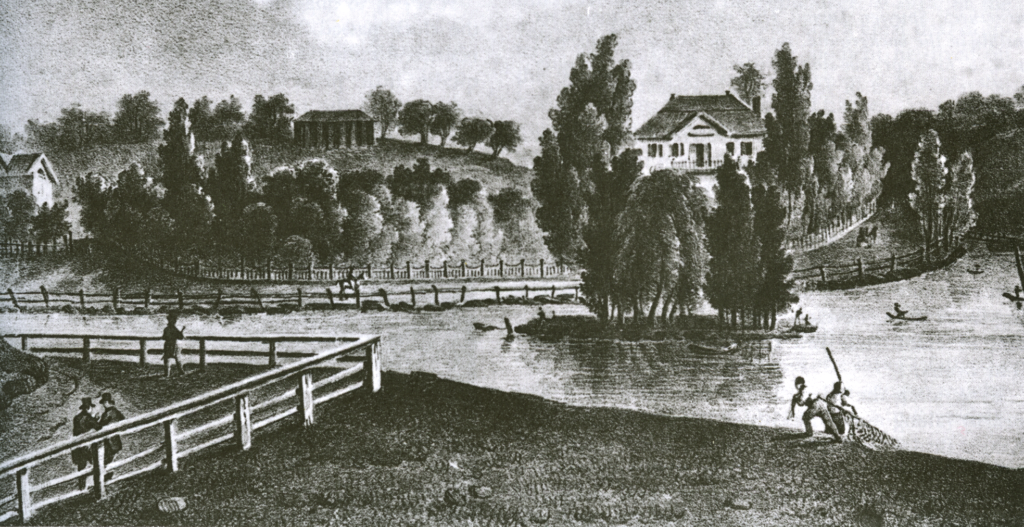
The old grist and saw mills at the end of the lake always appealed to me as of extraordinary interest, both on account of their age, and the fact that any machinery is fascinating to the average boy. Indeed it was a treat just to watch the huge overshot water-wheel turn slowly and spill the water in cascades from its buckets, and to go into the mill and watch the corn run from the hopper into the whirring mill-stones, then into the basement to inspect the queer wooden machinery and the bolting-machine with its fine silk bolting cloth, for the mill possessed a regular flouring plant, in addition to grinding corn into feed for the farmers’ cattle. In winter it was a haven of refuge for the skaters to warm themselves at the big stove. About the time the estate was taken by the City, an enterprising resident constructed in the basement of the old mill, a shuffle-board. The game was popular, and some of the players became experts. Sunday afternoons was when most of them met. It was a great sport, and I look on that period with pleasure.
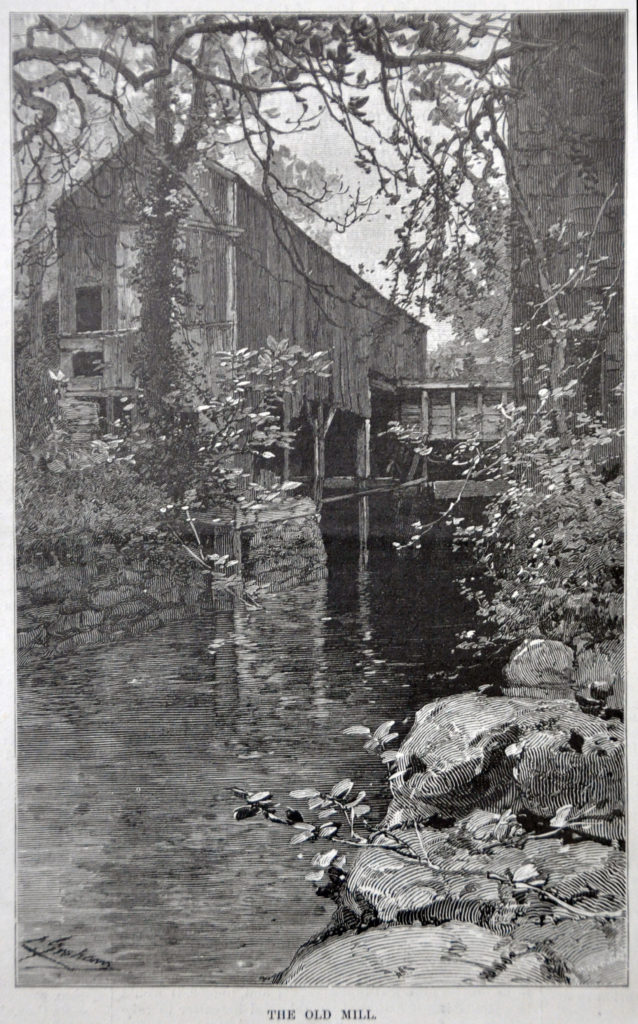
Adjoining the grist-mill on the west, across the mill-race was the saw-mill with its large “up and down” saw cutting logs into fence-posts, railroad ties, and stone-boat slabs. Around, outside lay huge logs. The site was picturesque. A big elm shaded the mill, on the bank opposite a large oak hung over the water, and to the west was a grove of locust and other trees. Many artists came there to sketch and paint. The site is still picturesque but alas! the old mill buildings have gone, having been struck by lightning and burned, and the big trees cut down. On the south bank of the lake George Tremper had four large ice-houses, from which he supplied the neighborhood. They were taken down after the City acquired the property, and the skate and golf-house built upon the site. Another old building was the Methodist Church Bethel, a plain frame edifice painted white, located on the west side of the Albany Post Road about 300 feet south of the old stone Hadley farmhouse and almost in the rear of an apartment house recently erected on Broadway. It was the oldest church in this section having been erected in 1835, the congregation before that date meeting, 1828, in an old schoolhouse near Warner’s store. When the new church was built on Broadway at Kingsbridge, the church was abandoned. It remained vacant for a long while and was finally sold to a doctor who remodelled it into a residence. I think it is still standing. About half way between it and the Hadley house was the largest black walnut tree I have ever seen, which was eventually felled for its valuable wood. This kind of tree is extremely scarce in this section.
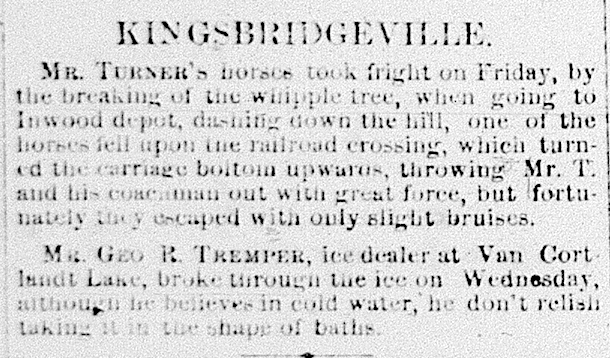
Churches Built
The next oldest church was the Episcopal Church of the Mediator on the west side of Church Street, Kingsbridge, built in 1855. It was of fram construction and afterward replaced by the present handsome stone edifice. Then came the Riverdale Presbyterian Church, built of stone quarried in the neighborhood, in 1863. Originally, it had a gallery across the east end, and the choir was at the rear slightly raised above the floor level. Both were shortly afterward removed. The auxiliary chapel of the church, known as the Edge Hill Chapel at Spuyten Duyvil, was built in 1869, and was served by the pastor of the Riverdale church. It is a small stone building of artistic design. In 1865 the handsome Christ Episcopal Church on Riverdale Avenue was built, also of stone from the locality. A little later the Catholic Church of St. Margaret was built. It was a small structure afterward replaced with the present fine structure. It stands near Riverdale Avenue at about 260th Street. Previous to its erection the members of that faith worshipped at St. John’s Chapel, built 1869, at Kingsbridge.
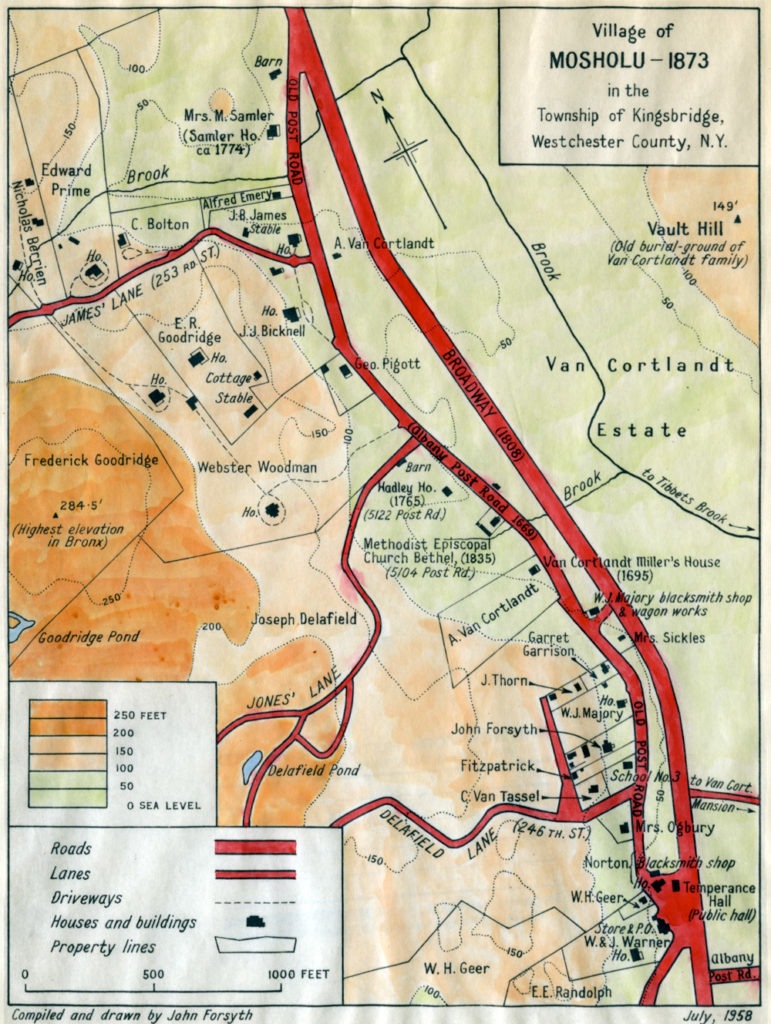
The oldest blacksmith shop, and carriage repair shop, was that owned and run by William Majorie–a tall, fine old-timer who lived to a great age. It was near and overlooking Broadway about on the site of the most southerly of the three little cottages formerly owned by the Van Cortlandts. Connected with it, was a stall for shoeing oxen that have to have a special equipment for the purpose. The stall was constructed of heavy timbers and just wide enough to accomodate the ox, straps of heavy leather and canvas were passed under the body and tightened by means of a winch until the feet just touched the floor. The foot to be shod was strapped to a timber, and the peculiarly shaped shoes fitted one to each half of the cloven hoof. Another shop, owned and operated by George Norton was built subsequently. It stood on a strip of land between Broadway and the Post Road. In a stone fence in the rear of the shop, and on the west side of the Post Road was embedded a milestone, erected by the man who ran the stage-line between New York and Albany. It has disappeared [Note: It is currently located in the Van Cortlandt House Museum]. When I came to Riverdale and for many years afterward, the country life was much more rural than at present, and life was primitive compared with today. The nearest source of supplies was Yonkers, the grocers and butchers sending their delivery wagons out three times per week. The streets were dirt roads, there was neither fire nor police protection, no mail delivery and no street lamps or public water system. One summer–I think it was that of 1876–was very dry and the wells and cisterns gave out, many families being obliged to haul their domestic water supply in casks from Van Cortlandt Lake. With the annexation of this section to New York City, the modern improvements were gradually introduced. I think it was previous to the annexation that Broadway and Riverdale Avenue were macadamized. I well remember this improvement to the avenue. A stone-crusher and engine were installed on the lot owned by Samuel D. Babcock, situated between Riverdale and Palisade Avenues, and 251st and 253rd Streets, where the stone was quarried and broken to the required size. It was sometime in the 1870’s and a period of great economic depression. The men working on the avenue had a song, the chorus of which was:
You can make it pay
Though you stick to it like glue,
For you cannot earn a dollar a day
On Riverdale Avenue!
In fact, the wages for ordinary labor were from ninety cents to one dollar per day.
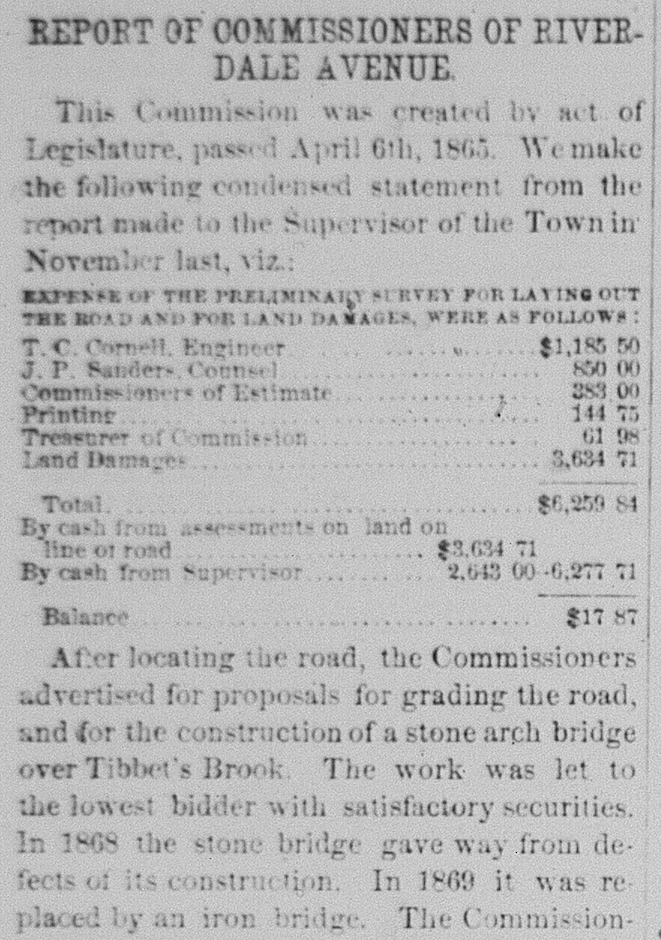
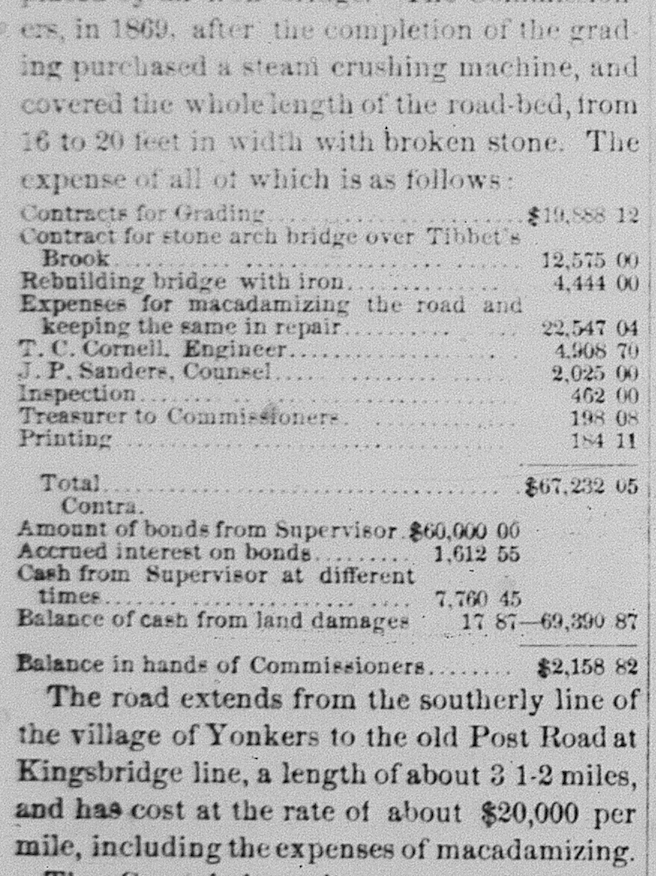
The Riverdale Avenue project was a major undertaking. This is part of an article about the construction from the December 28th edition of the Yonkers Statesman.
Social affairs in the early days, were at first informal, but soon city conventions were adopted. Dancing parties were frequent, at which gentlemen were required to wear gloves, and the invitations were delivered and answered by the coachman or footman. Lectures and “Hops” at the Riverdale Institute, then a ladies’ fashionable boarding school, were well attended. The building was subsequently used as a boys’ school, a high-class boarding house for several years kept by Misses Coombs, and finally remade into the residence of Mr. and Mrs. John H. Iselin. Most of the inhabitants were year-round residents, though social functions were not as frequent in winter as in summer, though the coasting and skating parties were popular. There was a boat club with a boathouse at the north end of the dock, housing several single scull shells, and an eight-oared barge. It fell into disuse years ago. Then came an archery club, holding its meetings on a large plot opposite the Morosini grounds. There was an amateur theatrical club, which gave plays at various private houses, and afterwards in the Temperance Hall, at Mosholu, where it installed a small stage and two changes of scenery [Note: This was a building operated by the Sons of Temperance, an anti-alcohol organization]. Tickets were in demand and the presentations well attended. As several of us school boys had relatives in the plays, we were allowed to attend the dress rehearsals, and the members used to say they were more susceptible to our criticism that than of the regular audience. Tennis was taken up enthusiastically, and courts constructed on the grounds of several residents. These were mostly of grass, as that kind of court was favored. A club court was laid out near Palisade Avenue, opposite the residence of Mrs. Bashford Dean. A favorite gathering place on a Saturday afternoon was at the court on the lawn of Mr. and Mrs. Dallas B. Pratt, now the home of Mrs. George W. Perkins, when after a lively set, a cup of shandygaff was most acceptable.
Winter Fun
In winter the young folks–and some of the older folks–found recreation and enjoyment skating on Van Cortlandt Lake. Before the coming of the railroad, their numbers were few, and there was plenty of room for lively games of shinny [hockey], but with easy transportation from 155th Street their numbers rapidly increased, and many city friends came out to enjoy the ice. A curling club from Yonkers had many a “bonspiel” here and a local club was formed, the members becoming proficient at the game and playing many a hard-fought match. Pat Devine’s little refreshment shanty did a rushing business in coffee, soft drinks, pies and sandwiches.
When there was a good fall of snow, evening coasting parties were popular on the many hills, residents often having friends out from the city to participate. The coasting was safe, as there were few sleights or other vehicles on the roads.
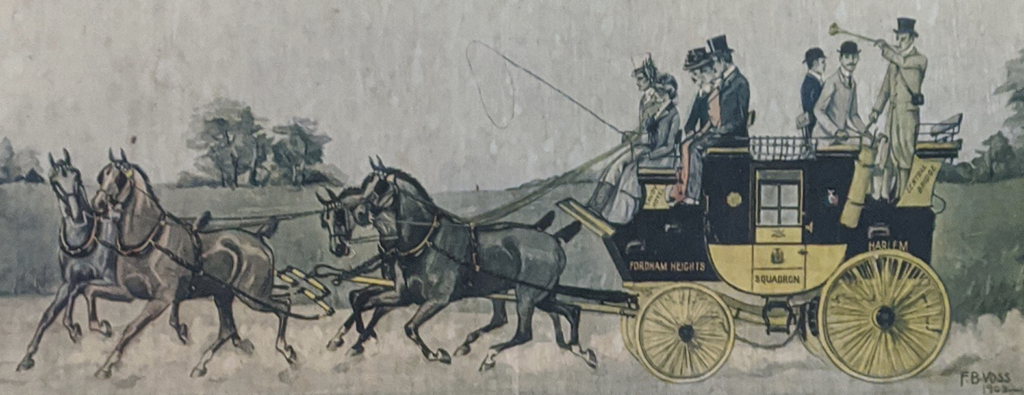
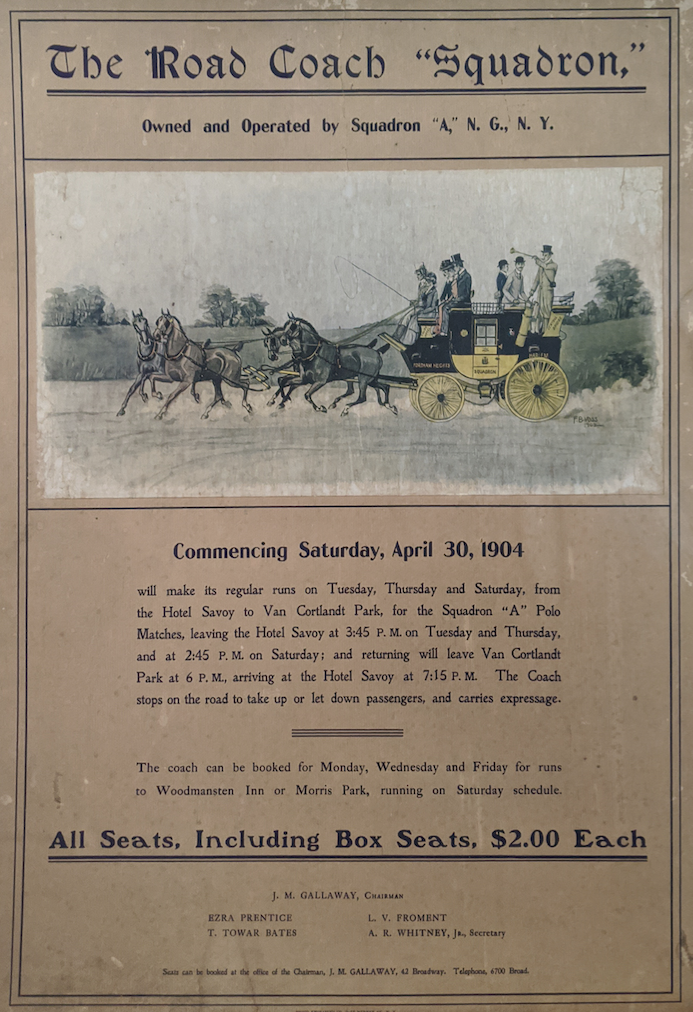
I must not omit to mention an event that caused much pleasurable excitement–the running of a coach owned and driven by Col. Delancey Kane, which started from the old Hotel Brunswick, New York, with a northern terminal at Getty Square, Yonkers, passing through Riverdale on Riverdale Avenue. It came up from the city in the afternoon, and returned the next morning; stopping at various points to discharge or take up passengers and many Riverdale residents availed themselves of the opportunity. The coach ran, I think, for two summers. It was an exhilarating experience to see the big coach with its four handsome, well-groomed horses, come at a lively clip down the avenue to the accompaniment of rattling harness chains and the melodious notes of the horn. The guard was a skillful performer and in additions to sounding the regular calls, would often play the air of “Who’ll Buy a Broom.”
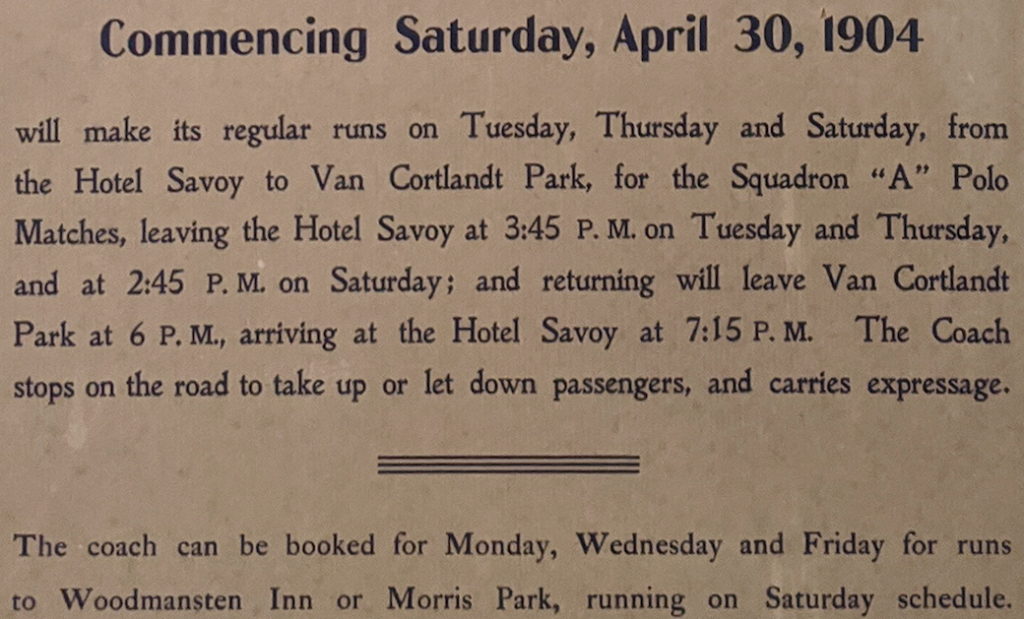
Close up of text from Advertisement.
I could tell of other events, but this contribution has grown long enough. The pleasure of recalling old times is dampened by the loss of old friends who have died or removed to other parts
(To Be Continued)
Comments can be left here.